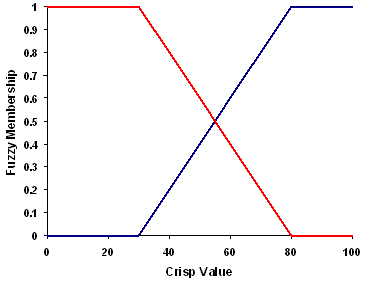Disponible avec une licence Spatial Analyst.
Résumé
Defines a fuzzy membership function through a linear transformation between the user-specified minimum value, a membership of 0, to the user-defined maximum value, which is assigned a membership of 1.
Discussion
The tool that uses the FuzzyLinear object: Fuzzy Membership.
The Linear function is useful when the smaller values linearly increase in membership to the larger values for a positive slope and opposite for a negative slope.
The Linear function does not work with negative numbers.

Syntaxe
FuzzyLinear (minimum, maximum)
| Paramètre | Explication | Type de données |
minimum | The value that will have a membership of 0. If the minimum value is less than the maximum, the linear function will have a positive slope. If the minimum value is greater than the maximum, the linear function will have a negative slope. (La valeur par défaut est Minimum of the input) | Double |
maximum | The value that will have a membership of 1. If the maximum value is greater than the minimum, the linear function will have a positive slope. If the maximum value is less than the minimum, the linear function will have a negative slope. (La valeur par défaut est Maximum of the input) | Double |
Propriétés
| Propriété | Explication | Type de données |
| minimum (Lecture et écriture) | The value that will have a membership of 0. If the minimum value is less than the maximum, the linear function will have a positive slope. If the minimum value is greater than the maximum, the slope will have a negative slope. | Double |
| maximum (Lecture et écriture) | The value that will have a membership of 1. If the maximum value is greater than the minimum, the linear function will have a positive slope. If the maximum value is less than the minimum, the slope will have a negative slope. | Double |
Exemple de code
Demonstrates how to create a FuzzyLinear class and use it in the FuzzyMembership tool within the Python window.
import arcpy
from arcpy.sa import *
from arcpy import env
env.workspace = "c:/sapyexamples/data"
outFzyMember = FuzzyMembership("as_std", FuzzyLinear(12, 16))
outFzyMember.save("c:/sapyexamples/fzyline")Performs a FuzzyMembership using the FuzzyLinear class.
# Name: FuzzyLinear_Ex_02.py
# Description: Scales input raster data into values ranging from zero to one
# indicating the strength of a membership in a set.
# Requirements: Spatial Analyst Extension
# Import system modules
import arcpy
from arcpy import env
from arcpy.sa import *
# Set environment settings
env.workspace = "C:/sapyexamples/data"
# Set local variables
inRaster = "as_std"
# Create the FuzzyLinear algorithm object
min = 19
max = 22
myFuzzyAlgorithm = FuzzyLinear(min, max)
# Execute FuzzyMembership
outFuzzyMember = FuzzyMembership(inRaster, myFuzzyAlgorithm)
# Save the output
outFuzzyMember.save("c:/sapyexamples/fzyline2")Rubriques connexes
Vous avez un commentaire à formuler concernant cette rubrique ?